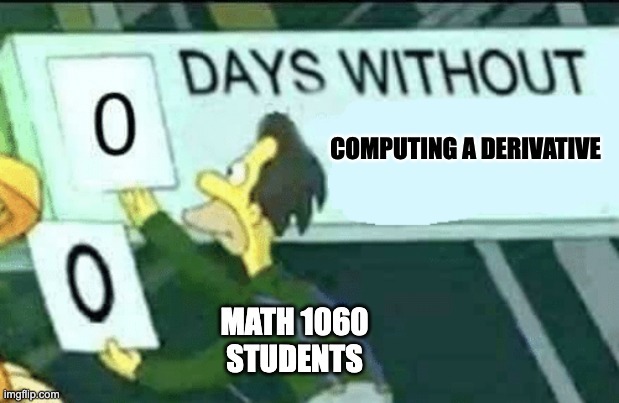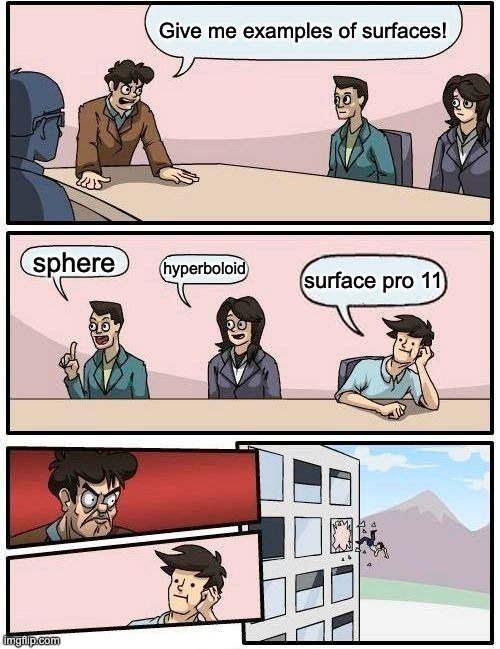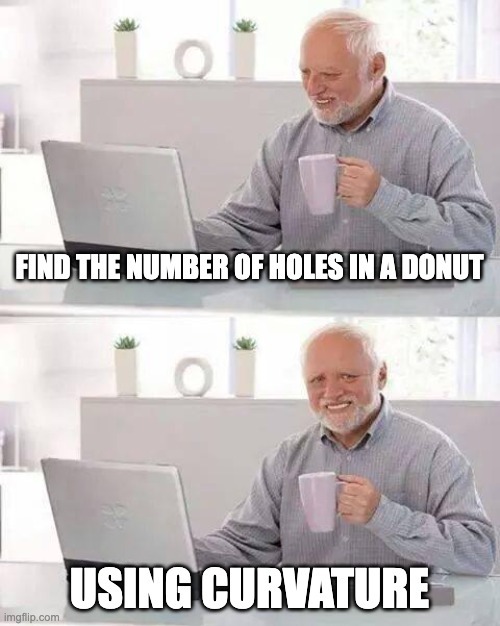Differential geometry (Math 1060)
Undergraduate course, Brown University, 2025
Announcements
- (12/4). Final exam practice problems. The final exam is cumulative with an emphasis on material from after the midterm (geodesics, covariant derivative, parallel transport, Gauss-Bonnet). In addition, I suggest you review the derivation of the Frenet equations because there will be a problem related to that.
- (12/1). No class this week. Work on your presentations!
- (11/27). Presentation schedule (moved to next week):
- Tues (12/9): Eric/Joel, Eddie/Michael, Sarah/Zakhar
- Thurs (12/11): Gavin/Jue, Liangkang, David/Jacob
- Final project rubric
Course information
This is an undergraduate course in differential geometry. The primary objects of study are curves and surfaces in 3-space. This course builds on multivariable calculus and linear algebra and could be a precursor to the study of manifolds, topology, and Riemannian geometry.
Course objectives
- learn basic properties of curves and surfaces (lengths, area, curvature, torsion) and how to compute them;
- prove foundational results (fundamental theorem of curves, theorem egregium, Gauss-Bonnet);
- understand theoretical trends in differential geometry (local vs global properties, intrinsic vs extrinsic quantities);
- improve your understanding of linear algebra and calculus by applying it;
- investigate various applications of differential geometry (isoperimetric inequality, regular isotopy of plane curves, knots, map-making, Euler characteristic/topology);
- improve your ability to read/write proofs and critique arguments;
- expose you to things you haven’t seen and challenge you through problem solving.
Recommended prerequisites
We will use multivariable calculus and linear algebra heavily and without much review during lecture. Some experience with writing proofs may also be helpful.
Textbook
do Carmo, Differential geometry of curves and surfaces
Course expenses
Just the textbook. In practice, the text may not be absolutely necessary for the course, although you may want it as a reference.
Grading
homework 30%, midterm 20%, final project 20%, final exam 20%, participation 10%
- a grade of 92% or higher is guaranteed an A
- a grade of 84% or higher is guaranteed an B
- a grade of 76% or higher is guaranteed an C
For students taking this course S/NC, a minimum grade of 70% and a minimum participation grade of 70% is required to guarantee a grade of S.
Contact information
- Instructor: Bena Tshishiku (bena_tshishiku at brown.edu)
- TA: Nathan Smith (nathan_smith at brown.edu)
Course events
Lectures: Tu-Th 9-10:20am in Smith-Buonanno Hall 206
Office hours:
- Bena: Tuesdays 5:30-6:30 and Wednesdays at 4:30-5:30 in Kassar 304, and by appointment
- Nathan: Thursdays 3-4 in Barus-Holley 161
Important dates:
- Midterm: week of Oct 27
- Final projects: Dec 2, 4, 9
- Final exam: Dec 13 at 9am
Homework
There will be weekly assignments posted below. The homework is designed to increase your engagement with the material, with your peers, and with me.
Collaboration: Please collaborate! Working together with your classmates can help you learn the material better. Some of the homework problems may be difficult, so it is recommended that you talk to someone when you are stuck. You are required to write your solutions alone and acknowledge the students you worked with. For any solution you submit, you should understand it well enough that you can explain it to someone else and answer questions about it. If you find yourself writing down things that you can’t explain, you should go back and think more about the problem.
LaTeX: Homework solutions must be typed in LaTeX. If you’re new to LaTeX, you can either download LaTex or use sharelatex which allows you download, edit, and compile LaTeX files online. See here for some commonly used symbols in LaTeX. Also Detexify is a useful tool for finding the commands for various symbols. The source code for the assignments should be a helpful guide. The most basic thing to know/remember is that math always goes in between dollar signs.
Late homework policy: For your homework grade, I will drop the score from your lowest assignment. View this as a one-time “get out of jail free card” in the event that you oversleep, forget, have a midterm, etc. As a general rule, late homework will not be accepted. If you have an emergency (medical, family, …), you will need to send a dean’s note before the assignment is due.
Homework assignments.
HW1 (due 9/12). TeX file, student solutions
HW2 (due 9/26). TeX file, student solutions
HW3 (due 10/3). TeX file,
student solutions
HW4 (due 10/10). TeX file, image (include this in the same folder as your text file), student solutions
HW5 (due 10/17). TeX file, student solutions
HW6 (due 10/23). TeX file, student solutions
HW7 (due 11/14). TeX file, student solutions
HW8 (due 11/21). TeX file, student solutions
Participation
Occasionally, we may have small assignments or quizzes in class (randomly). These count toward the participation part of your grade (10%). Attending class and taking notes is a basic part of course participation. If you have to miss class, I expect that you will get notes from a classmate.
Course materials
- For asynchronous discussions (e.g. questions about homework) we will use Campuswire. Join here with entry code 2308.
- If you need additional references (outside of lecture and do Carmo), I encourage you to find the resource that works best for you. There are other popular texts by Banchoff-Lovett and Shifrin.
Final Project
Working in groups of 2, you’ll choose a topic and give an N-minute presentation at the end of the semester.
The topic should be something related to the course that interests you. Below are some topic ideas to get you started, but you don’t have to choose one of these.
As part of completing the final project, I will ask you to submit:
- A project proposal, due 11/10
- A project outline, due 11/17
- Final presentation slides
- Final project rubric
Some potential topics to get you started:
- Compact + constant Gauss curvature implies spherical (do Carmo 5.2)
- Isoperimetric inequality (do Carmo 1.7)
- four vertex theorem (do Carmo 1.7)
- Crofton length formula (do Carmo 1.7)
- Fundamental theorem of surfaces (do Carmo appendix to Section 4)
- Hopf-Rinow theorem (do Carmo 5.3)
- differentiable Jordan curve theorem (do Carmo 5.7)
- Fenchel’s theorem/total curvature of plane curves (do Carmo 5.7)
- knotted curves and the Fary-Milnor theorem (do Carmo 5.7)
- surfaces with zero Gaussian curvature (do Carmo 5.8)
- abstract definition of a Riemannian surface (do Carmo 5.10)
- Gauss linking formula
- Fundamental theorem of curves in higher dimensions
- Anything else that interests you and is tied to the course content.
Tentative schedule (subject to change)
- Week 1: do Carmo Sections 2.1-2.2, 2.4
- Thurs (9/4). calculus review, surfaces, tangent spaces
- Week 2: do Carmo Sections 2.4-2.5
- Tues (9/9). more surfaces, tangent spaces; virtual lecture
- Thurs (9/11). No class: work on HW1, review MVC, …
- Fri (9/12). HW1 due
- Week 3: do Carmo Sections 2.5, 1.2, 1.3
- Tues (9/16). first fundamental form
- Thurs (9/18). lengths and areas
- Fri (9/19).
- Week 4: do Carmo Section 1.5
- Tues (9/23). curves, examples, unit-speed parameterizations
- Thurs (9/25). plane curves, curvature
- Fri (9/26). HW2 due
- Week 5: do Carmo Sections 1.5, 3.1-3.2
- Tues (9/30). fundamental theorem plane curves, Frenet frame
- Thurs (10/2). fundamental theorem of space curves
- Fri (10/3). HW3 due
- Week 6: do Carmo Sections 3.2
- Tues (10/7). surface Gauss map
- Thurs (10/9). Gauss map self-adjointness, second fundamental form
- Fri (10/10). HW4 due
- Week 7: do Carmo Sections 3.3, 4.3
- Tues (10/14). surface curvatures
- Thurs (10/16). curvatures in coordinates
- Fri (10/17). HW5 due
- Week 8: do Carmo Sections 4.3-4.4
- Tues (10/21). Theorem egregium
- Thurs (10/23). surface Frenet frame,
- Fri (10/24). HW6 due next Tuesday
- Week 9: do Carmo Sections 4.4-4.5
- Tues (10/28). Gauss-Codazzi equations
- Thurs (10/30). no class (midterm)
- Fri (10/31). no HW (midterm)
- Week 10:
- Tues (11/4). geodesics
- Thurs (11/6). covariant derivatives
- Fri (11/7). final project proposal due Monday 11/10.
- Week 11:
- Mon (11/10). final project proposal due
- Tues (11/11). (local) Gauss-Bonnet
- Thurs (11/13). Gauss-Bonnet
- Fri (11/14). HW7 due
- Week 12:
- Mon (11/17). final project outline due
- Tues (11/18). Hairy ball theorem, vector fields on spheres
- Thurs (11/20). Vector field index theorem, parallel transport and curvature
- Fri (11/21).
- Week 13:
- Mon (11/24). final project slides due Tuesday
- Tues (11/25). abstract Riemannian manifolds, FTA
- Thurs (11/27). No class (thanksgiving)
- Fri (11/28). HW8 due
- Week 14:
- Tues (12/2). no class (work on final presentation)
- Thurs (12/4). no class (work on final presentation)
- Week 15: (reading period)
- Tues (12/9). final project presentations: Eric/Joel, Eddie/Michael, Sarah/Zakhar
- Thurs (12/11). final project presentations: Gavin/Jue, Liangkang, David/Jacob
- Sat (12/13). final exam
Tips for success
- Attend lecture.
- Read the book. Doing this before lecture may help you absorb the lectures better.
- Try the homework problems alone before working with others or coming to office hours. Identifying where you get stuck can make office hours more productive.
- Come to office hours. There are many good uses of office hours: ask questions related to homework, lecture, or the book; go over something you’re confused about; work on your homework alone or in a group; ask for advice on how to improve in the course; ask about something only tangentially related to the course.
- Use the homework to better understand the material. A pretty good general approach to doing homework problems is to follow UMER: (1) Understand the problem: review all relevant definitions, do some examples, draw a picture; (2) Make a plan: come up with strategies to solve the problem, which results from class are relevant; (3) Execute: try one of your strategies, and if it doesn’t work (this is normal), try another, go back to steps (1) and (2) as necessary; (4) Reflect on your solution: after you’ve solved the problem (great) there is more to do(!), check your work, did you miss any steps, can you simplify or improve your solution, are there any big-picture take-aways. Each step of UMER should reinforce your understanding of the course material. Overall, the homework should be fun if you have a good sense of UMER.



